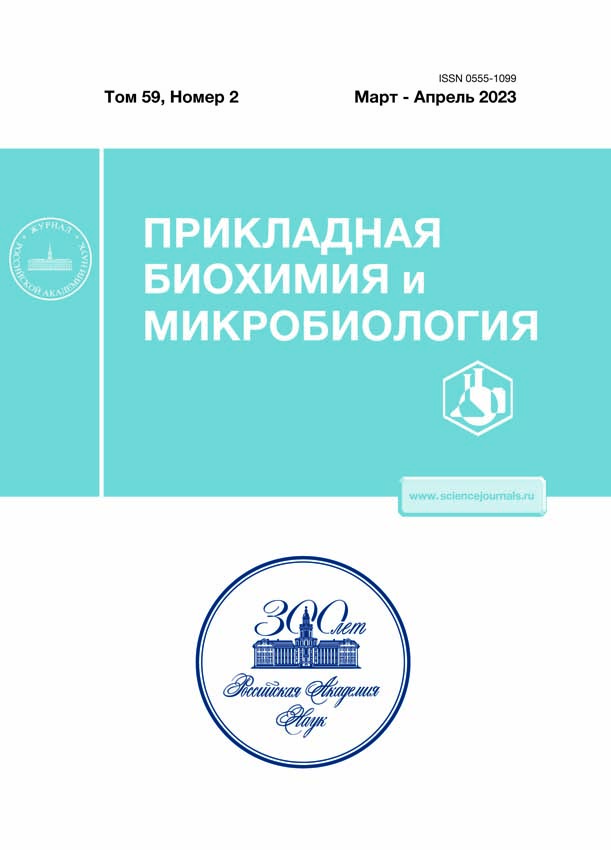Influence of Bacterial Mutualists and Phytopatogenes on Changes in Concentrations of cAMP and H2O2 in Pea Seedles of Rondo Varieties and its Clutterless and Superclub Mutants
- Autores: Lomovatskaya L.A.1, Zakharova O.V.1, Goncharova A.M.1, Romanenko A.S.1
-
Afiliações:
- Siberian Institute of Plant Physiology and Biochemistryof the Siberian Branch of RAS
- Edição: Volume 59, Nº 2 (2023)
- Páginas: 200-207
- Seção: Articles
- URL: https://cardiosomatics.ru/0555-1099/article/view/674636
- DOI: https://doi.org/10.31857/S0555109923020113
- EDN: https://elibrary.ru/LLWBKA
- ID: 674636
Citar
Texto integral
Resumo
Changes in the concentrations of hydrogen peroxide and cyclic adenosine monophosphate (cAMP) in the roots of seedlings of pea cv. Rondo and its supernodulating mutant Nod3 and anodulating K14 were studied during infection with Rhizobium leguminosarum bv. vicea (strain RCAM 1022) or Pseudomonas syringae pv. pisi (strain 1845). It was shown that 360 min after infection of pea seedlings of the Rondo variety, the level of endogenous hydrogen peroxide slightly differed from the control. In the roots of Nod3 seedlings, this level significantly decreased, and in the roots of K14 it significantly increased when infected with the 1845 strain, but remained unchanged when exposed to bacteria of the RCAM 1022 strain. and young root hairs of Rondo seedlings, while strain 1845 had no effect on this parameter. Both types of bacteria had no effect on the concentration of cAMP in the roots of seedlings of the Nod3 mutant, whereas in K14, under the influence of RCAM 1022, the cAMP level almost doubled, and under the influence of 1845, it decreased. It is assumed that hydrogen peroxide and cAMP may be involved in the formation of supernodulating and nodulating phenotypes of mutants, as well as in the formation of resistance to a specific pathogen, Pseudomonas syringae pv. pisi. It is possible that this phenomenon can be used to diagnose the resistance of newly created mutants and pea varieties to the blight pathogen.
Sobre autores
L. Lomovatskaya
Siberian Institute of Plant Physiology and Biochemistryof the Siberian Branch of RAS
Autor responsável pela correspondência
Email: LidaL@sifibr.irk.ru
Russia, 664033, Irkutsk
O. Zakharova
Siberian Institute of Plant Physiology and Biochemistryof the Siberian Branch of RAS
Email: LidaL@sifibr.irk.ru
Russia, 664033, Irkutsk
A. Goncharova
Siberian Institute of Plant Physiology and Biochemistryof the Siberian Branch of RAS
Email: LidaL@sifibr.irk.ru
Russia, 664033, Irkutsk
A. Romanenko
Siberian Institute of Plant Physiology and Biochemistryof the Siberian Branch of RAS
Email: LidaL@sifibr.irk.ru
Russia, 664033, Irkutsk
Bibliografia
- Власова Е.Ю., Сидорова К.К., Гляненко М.Н., Мищенко Т.М. // Вавиловский журнал генетики и селекции. 2012. Т. 16. № 4/2. С. 879–886.
- Nanda A.K., Andrio E., Marino D., Pauly N., Dunand C. // J. Integrative Plant Biology. 2010. V. 52. № 2. P. 195–204.
- Torres M.A. // Physiologia Plantarum. 2010. V. 138. № 4. P. 414–429.
- Ma W., Qi Z., Smigel A., Walker R.K., Verma R., Gerald A. Berkowitz G.A. // PNAS. 2009. V. 106. № 49. P. 20995–21000.
- Ломоватская Л.А., Кузакова О.В., Гончарова А.М., Романенко А.С. // Физиология растений. 2020. Т. 67. № 3. С. 270–277. https://doi.org/10.1134/S0015330320020104
- Suzuki N., Katano K. // Front. Plant Sci. 2018. V. 9. P. 490. https://doi.org/10.3389/fpls.2018.00490
- Макарова Л.Е., Нурминский В.Н. // Цитология. 2005. Т. 47. № 6. С. 519–525.
- Ломоватская Л.А., Кузакова О.В., Романенко А.С., Гончарова А.М. // Физиология растений. 2018. Т. 65. № 4. С. 310–320.
- Galletti R., Denoux C., Gambetta S., Dewdney J., F.M. De Lorenzo A., Ferrari S. // Plant. Physiol. 2008. V. 148. P. 1695–1706.
- Звягинцев Д.Г., Бабьева И.П., Зенова Г.М. М.: Изд-во МГУ, 2005. 445 с.
- Bleau J.R., Spoel S.H. // Plant Physiol. 2021. V. 186. P. 53–65.
- Tsyganova A.V., Brewin N.J., Tsyganov V.E. // Cells. 2021. V. 10. № 1050. P. 1–32.
- Кузакова О.В., Ломоватская Л.А., Гончарова А.М., Романенко А.С. // Физиология растений. 2019. Т. 66. № 5. С. 360–366.
- Bhuvaneswari T.V., Turgeon B.G., Bauer W.D. // Plant Physiol. 1980. V. 66. № 6. P. 1027–1031.
- Серегина Н.В., Честнова Т.В., Жеребцова В.А., Хромушин В.А. // Вестник новых медицинских технологий. 2008. № 4. С. 75–77.
- Цыганова А.В., Цыганов В.Е. // Успехи современной биологии. 2012. Т. 132. № 2. С. 211–222.
- Вершинина З.P., Лавина А.M., Чубукова О.B. // Биомика. 2020. Т. 12. № 1. С. 27–49. https://doi.org/10.31301/2221-6197.bmcs.2020-3
- Жуков В.А., Рычагова Т.С., Штарк О.Ю., Борисов А.Ю., Тихонович И.А. // Экологическая генетика. 2008. Т. 6. № 4. С. 12–19.
- Бабоша А.В. // Журн. общей биологии. 2008. Т. 69. № 5. С. 379–396.
- Peleg–Grossman S., Melamed–Book N., Levine A. // Plant Signaling & Behavior. 2012. V. 7. № 3. P. 409–415.
- Hawkins J.P., Oresnik I.J. // Front. Plant Sci. 2022. https://doi.org/10.3389/fpls.2021.796045
- Bleau J.R., Spoel S.H. // Plant Physiol. 2021. V. 186. P. 53–65. https://doi.org/10.1093/plphys/kiaa088
- Gourion B., Berrabah F., Ratet P., Stacey G. // Trends in Plant Sci. 2015. V. 20. № 3. P. 186–194.
- Bolwell G.P., Bindschedler L.V., Blee K.A., Butt V.S., Davies D.R., Gardner S.L., Minibayeva F. // J. Exp. Bot. 2002. V. 53. № 372. P. 1367–1376.
- Ca’rdenas L., Martı’nez A., Sa’nchez F., Quinto K. // Plant J. 2008. V. 56. P. 802–813. https://doi.org/10.1111/j.1365-313X.2008.03644.x
- Takemoto J.Y., Zhang L., Taguchi N., Tachikawa T., Miyakawa T. // Microbiology. 1991. V. 137. № 3. P. 653–659.
- Ichinose Y., Taguchi F., Mukaihara T. // J. Gen. Plant Pathol. 2013. № 79. P. 285–296.
- Terakado J., Fujihara S., Yoneyama T. // Soil Sci. & Plant Nutr. 2003. V. 49. № 3. P. 459–462.
- Xu R., Guo Y., Peng S.,Liu J., Li P., Jia W., Zhao J. // Biomolecules. 2021. V. 1. P. 688. doi.org/10.3390
- Сидорова К.К., Шумный В.К. // Сибирский экологический журн. 1999. № 3. С. 281–288.
- Sabetta W., Vandelle E., Locato V., Costa A., Cimini S., Moura A.B., Luoni L., Graf A., Viggiano L., De Gara L., Bellin D., Blanco E., de Pinto. M.C. // Plant J. 2019. V. 98. P. 590–606.
Arquivos suplementares













